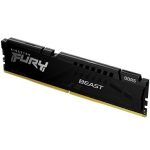DDR5 memory is the latest standard for computer system RAM (random access memory) and is due to replace the previous generation, DDR4, over the coming years. The first processor platform to support this memory standard was Intel’s 12th Gen Core, which could work with either DDR5 or DDR4 depending on the motherboard used. AMD’s Ryzen 7000-series processors, released in the second half of 2022, also support DDR5. Workstation-class CPUs were slower to adopt this technology, but Intel’s Xeon W-2400 and W-3400 chips arrived in 2023 and utilize DDR5 Registered memory modules.
So what makes DDR5 an improvement over previous generations? There are several areas of advancement:
- Higher clock frequencies – For example, Intel’s Core i9 12900K supports DDR4 speeds up to 3200 MT/s while it can handle DDR5 at up to 4800 MT/s.
- Increased reliability – DDR5 has a new feature called On-die ECC (error checking and correcting) which protects data integrity inside each memory chip. This is a nice addition, but it is not a replacement for full ECC memory in servers and mission-critical systems because it cannot monitor for or fix errors that happen to data in transit over the memory bus.
- Increased memory capacity – This may not be seen on the market for a while, but DDR5 has double the number of memory banks which will allow for more memory per module when manufacturers want to offer larger capacities
- Less power hungry – DDR5 has a base operating voltage of 1.1V versus 1.2V for DDR4, though high-performance modules from both generations often demand more power.
- Onboard voltage regulation – With DDR5, voltage regulation is handled on each memory module instead of on the motherboard. This reduces motherboard complexity and cost slightly, but that shift means more complex and costly memory modules instead.
That last “upgrade” was particularly problematic for the initial rollout of DDR5, however, because the power management integrated circuits (PMICs) that are needed for each stick of DDR5 memory were in shortage during early 2022. That limit on production capacity delayed our DDR5 launch here at Puget Systems, but we now offer it across many of our system configurations. The faster speed, increased stability, and potential for larger memory capacities that DDR5 brings to our workstations is exciting!
Configure an Intel Core Workstation with DDR5
Articles with DDR5 Performance Details
DDR5 Memory Speed Performance Scaling in Content Creation
Video Post-Production
3D Design & Rendering
Photo Editing
Configure Your Workstation Now!
Why Choose Puget Systems?
Built Specifically for You
Unlike a generic workstation or server, our systems are designed around your unique workflow and optimized for the work you do every day.
We’re Here, Give Us a Call!
We make sure our representatives are as accessible as possible, by phone and email. At Puget Systems, you can actually talk to a real person!
Fast Build Times
By keeping inventory of our most popular parts, and maintaining a short supply line to parts we need, we are able to offer industry-leading ship times.
Lifetime Labor & Tech Support
Even when your parts warranty expires, we continue to answer your questions and service your computer system with no labor costs.
